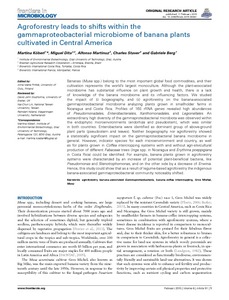Resource information
Bananas (Musa spp.) belong to the most important global food commodities, and their cultivation represents the world's largest monoculture. Although the plant-associated microbiome has substantial influence on plant growth and health, there is a lack of knowledge of the banana microbiome and its influencing factors. We studied the impact of (i) biogeography, and (ii) agroforestry on the banana-associated gammaproteobacterial microbiome analyzing plants grown in smallholder farms in Nicaragua and Costa Rica. Profiles of 16S rRNA genes revealed high abundances of Pseudomonadales, Enterobacteriales, Xanthomonadales, and Legionellales. An extraordinary high diversity of the gammaproteobacterial microbiota was observed within the endophytic microenvironments (endorhiza and pseudostem), which was similar in both countries. Enterobacteria were identified as dominant group of above-ground plant parts (pseudostem and leaves). Neither biogeography nor agroforestry showed a statistically significant impact on the gammaproteobacterial banana microbiome in general. However, indicator species for each microenvironment and country, as well as for plants grown in Coffea intercropping systems with and without agri-silvicultural production of different Fabaceae trees (Inga spp. in Nicaragua and Erythrina poeppigiana in Costa Rica) could be identified. For example, banana plants grown in agroforestry systems were characterized by an increase of potential plant-beneficial bacteria, like Pseudomonas and Stenotrophomonas, and on the other side by a decrease of Erwinia. Hence, this study could show that as a result of legume-based agroforestry the indigenous banana-associated gammaproteobacterial community noticeably shifted.


